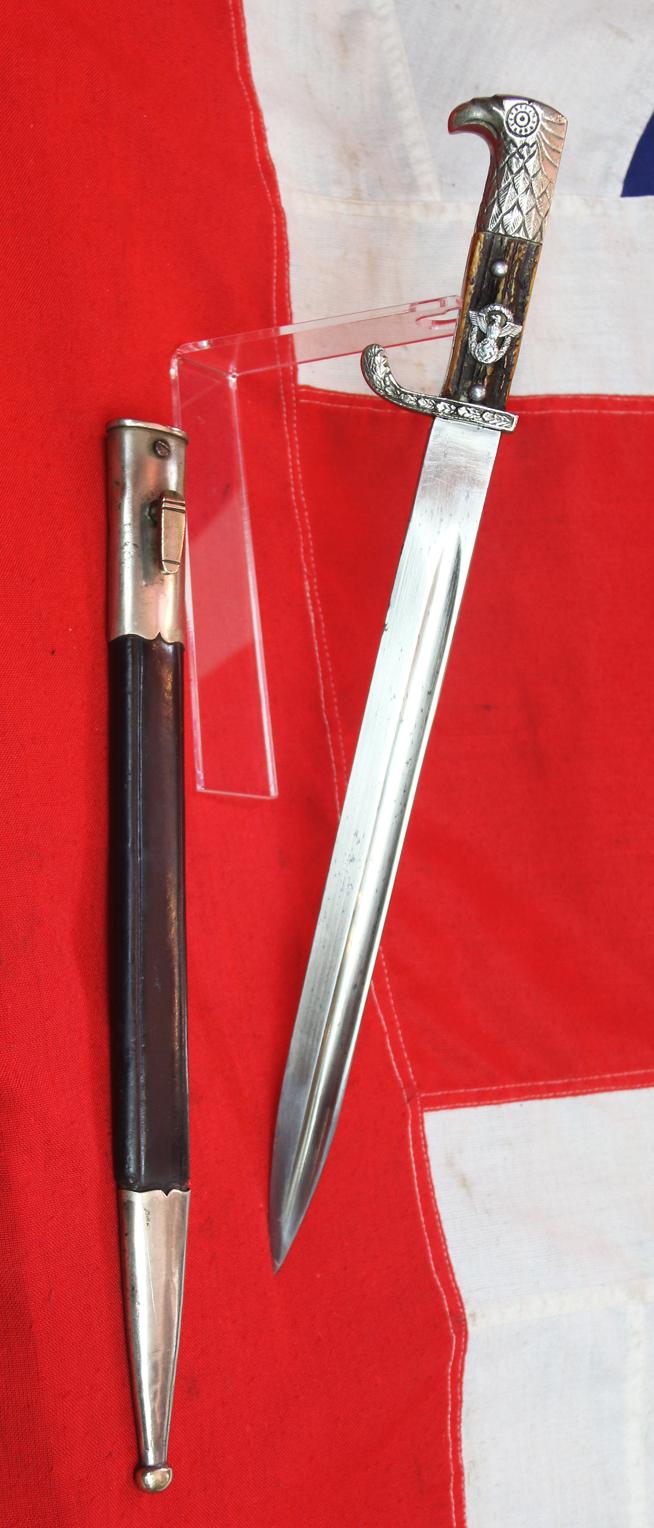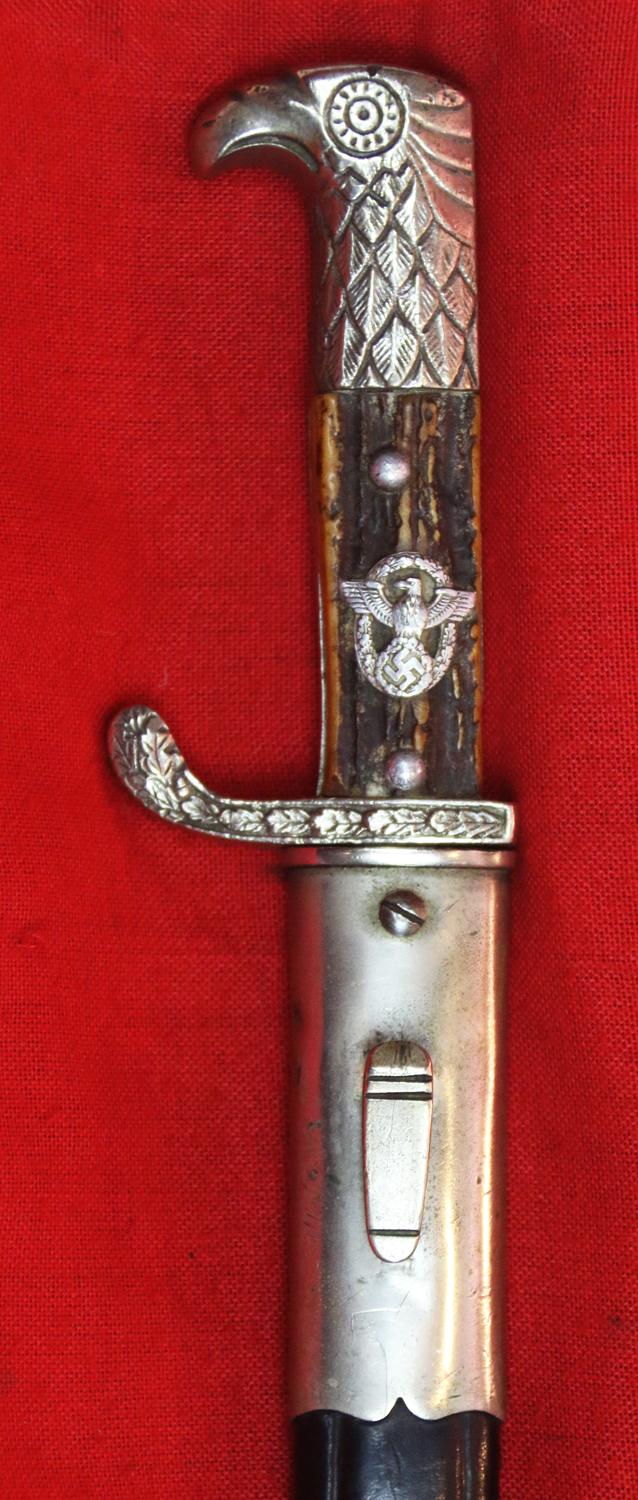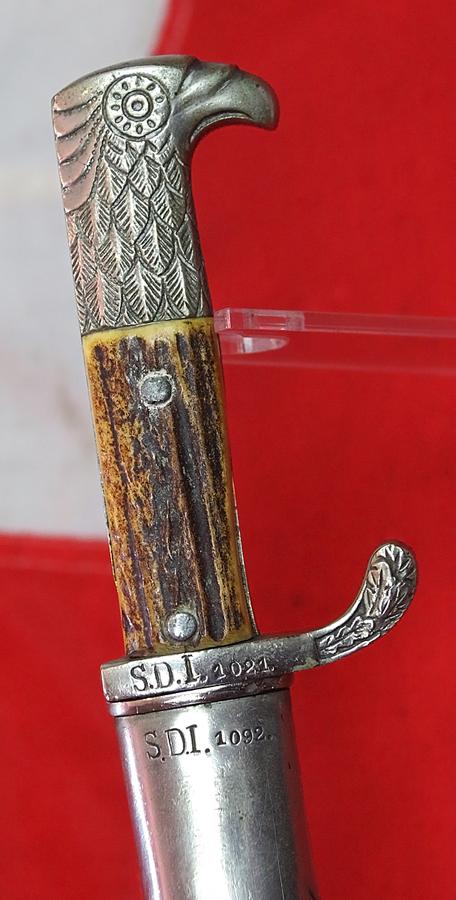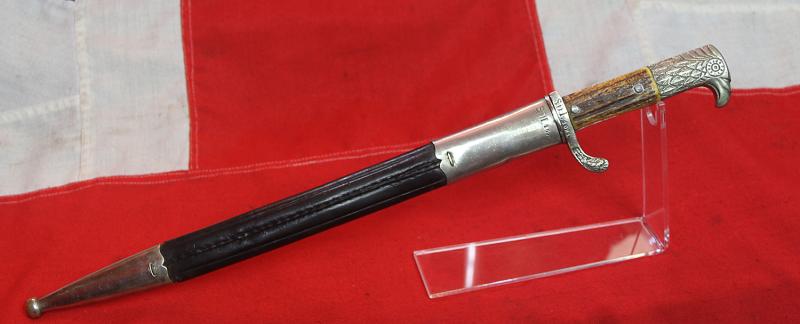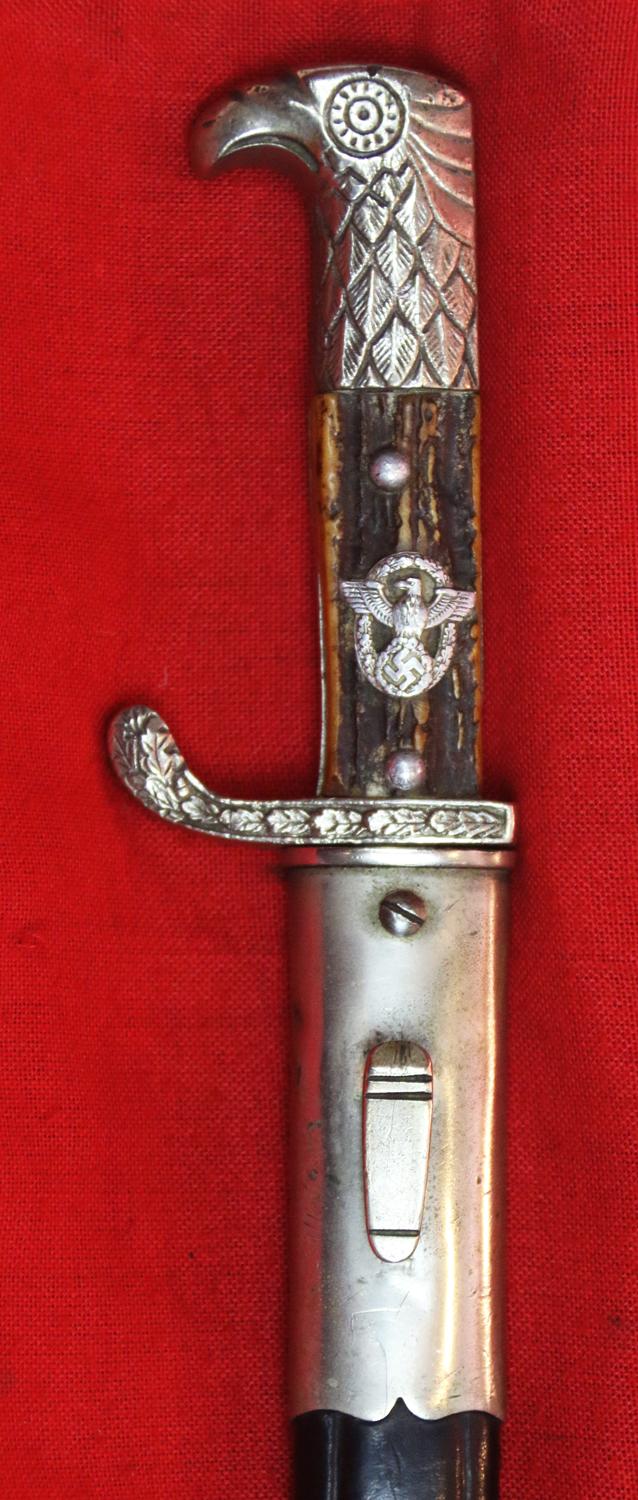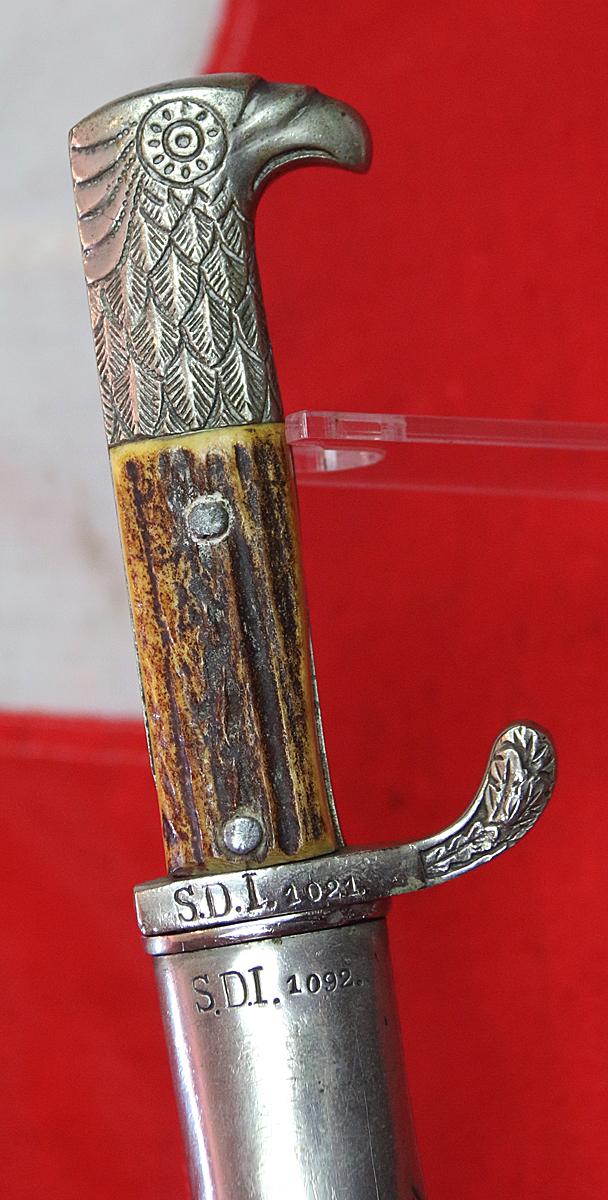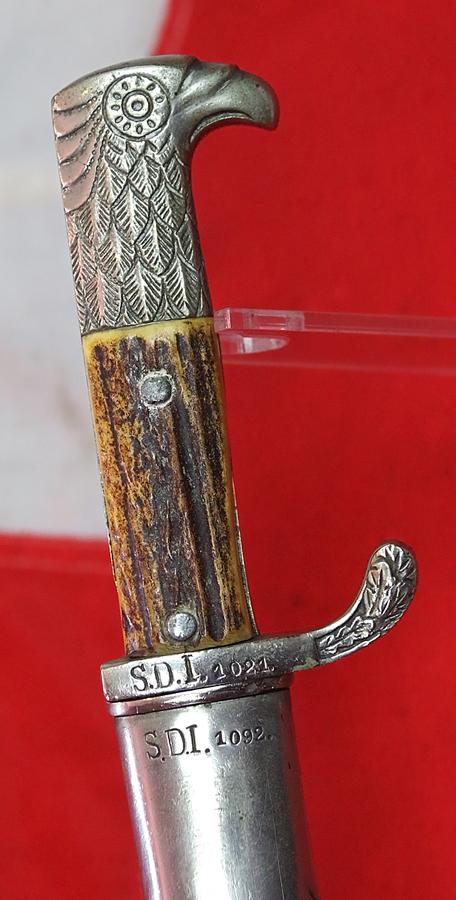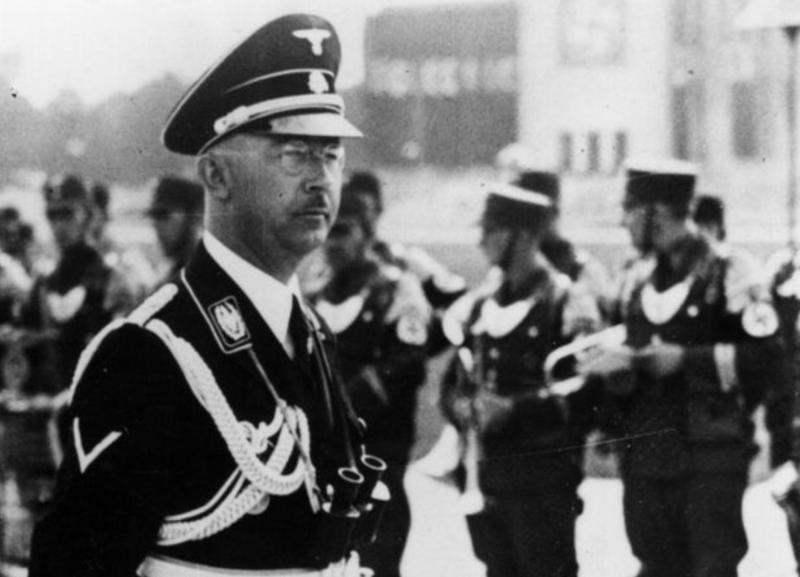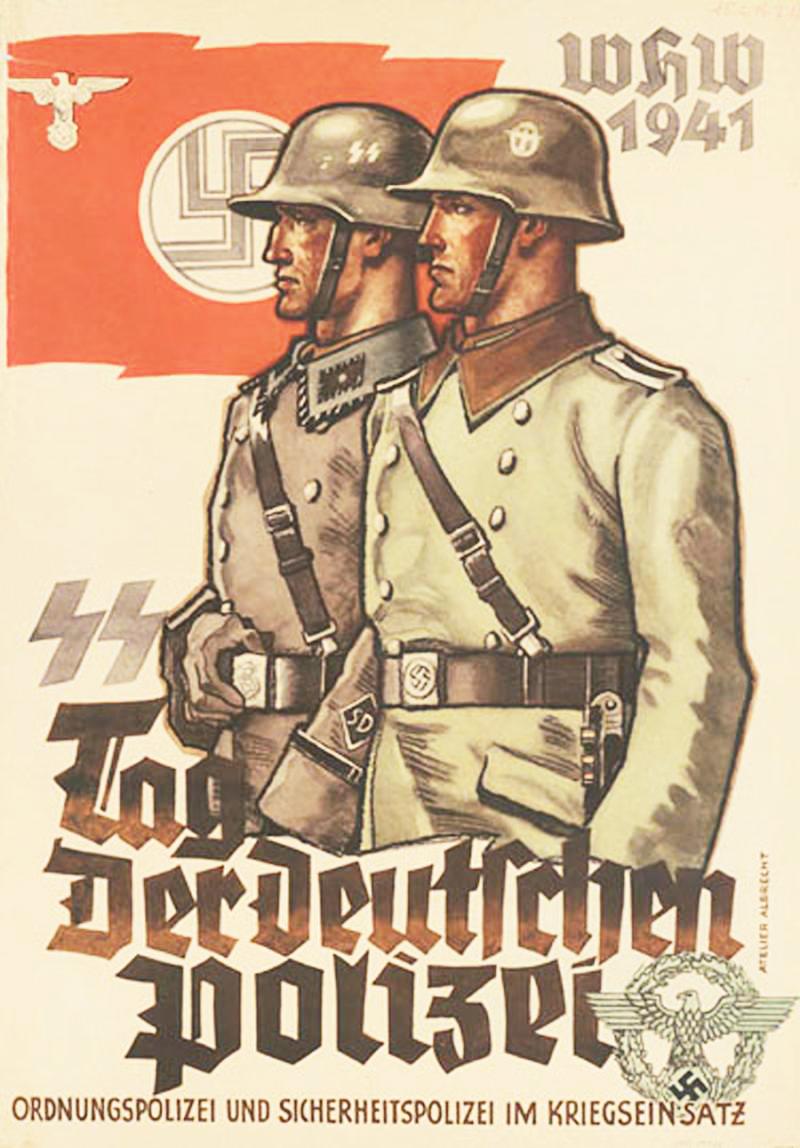A Very Fine, Section Marked, S.D., WW2 German Polizei Dagger. by Holler. One of Two Polizei Daggers Just Arrived But Sold Seperately.
We acquired a stunning pair, but we are selling them separately. this example is S.D. stamped.
Now both sold.
They are WW2 veteran’s war trophies, direct from the family of their original veteran, and never before seen upon the open collector’s market.
When Hitler came to power, the many German Police organizations still operating through their respective states and provinces were centralized under the guidance of SS-Reichsführer Himmler. Reinhard Heydrich’s had command over the SD, the SS Security Service of the NS Movement. At that point, the foundations of the Nazi police state were firmly laid, and the agencies for controlled police terror
An absolutely superb example, that would be most unlikely to improve upon. With serial numbers. Pommel form: eagle head Stylised feathers are depicted in relief. Pommel meets grips vertically. Grips form: two-piece staghorn retained by two large dome-headed rivets. Underside of grips very slightly shaped to hand, back flat and straight. Pinned between the retaining rivets of the right grip is a white metal badge in the form of the Wehrmacht eagle surmounting a swastika enclosed by a small circular wreath. The eagle's wings rest upon an open oval oakleaf wreath. Crossguard form: lower guard formed into short backswept quillon with flared terminal. Upper guard, extending above back of blade, is concave ground. Left and right sides, except for that section stamped with the unit mark, are adorned with oakleaves and acorns in low relief. Blade form: long, single-edged, spear point, fullered. Fullers from crossguard and extend to blade tip. Bayonet finish: all metal parts nickel plated.
Himmler and Heydrich wanted to extend the power of the SS; thus, they urged Hitler to form a national police force overseen by the SS, to guard Nazi Germany against its many enemies at the time real and imagined. He fused the Criminal Investigative Police (Kripo) and the Gestapo (the political police) to form the Security Police (Sicherheitspolizei or Sipo)
The S.D. and Sipo Interior Minister Frick also wanted a national police force, but one controlled by him, with Kurt Daluege as his police chief. Hitler left it to Himmler and Heydrich to work out the arrangements with Frick. Himmler and Heydrich had greater bargaining power, as they were allied with Frick's old enemy, Goring. Heydrich drew up a set of proposals and Himmler sent him to meet with Frick. An angry Frick then consulted with Hitler, who told him to agree to the proposals. Frick acquiesced, and on 17 June 1936 Hitler decreed the unification of all police forces in the Reich, and named Himmler Chief of German Police. In this role, Himmler was still nominally subordinate to Frick. In practice, however, the police was now effectively a division of the SS, and hence independent of Frick's control. This move gave Himmler operational control over Germany's entire detective force. He also gained authority over all of Germany's uniformed law enforcement agencies, which were amalgamated into the new Ordnungspolizei (Orpo: "order police"), which became a branch of the SS under Daluege. The Ordnungspolizei was separate from the SS and maintained a system of insignia and Orpo ranks. It was possible for policemen to be members of the SS but without active duties. Police generals who were members of the SS were referred to simultaneously by both rank titles during the war. For instance, a Generalleutnant in the Police who was also an SS member would be referred to as SS Gruppenfuhrer und Generalleutnant der Polizei. In addition, those Orpo police generals that undertook the duties of both Senior SS and Police Leader (Huhere SS und Polizeifuhrer) gained equivalent Waffen-SS ranks in August 1944 when Himmler was appointed Chef der Ersatzheeres (Chief of Home Army), because they had authority over the prisoner-of-war camps in their area.
Heinrich Himmler's ultimate aim was to replace the regular police forces of Germany with a combined racial/state protection corps (Staatsschutzkorps) of pure SS units. Local law enforcement would be undertaken by the Allgemeine-SS with the Waffen-SS providing homeland-security and political-police functions. Historical analysis of the Third Reich has revealed that senior Orpo personnel knew of Himmler's plan and were opposed to it.
The design of the dagger (with eagle head pommel, horn grip plates and leather scabbard) originated for the Prussian police in 1929. Those style bayonet knives are by far the most found by collectors as the Prussian police force was by far the largest in Germany. The Prussian design bayonet was chosen by the Nazis as the design for their nationalized police in 1936. The Prussian police produced two hilt designs: with bayonet attachment and without. Those bayonets produced with bayonet attachment fittings were issued to members of the Schutzpolizei Bereitschaften (Protection Police Riot/Emergency Companies) while the other style were issued to all other members of the Schutzpolizei, the Landjagerei (rural police using brown color leather scabbards) and the Gemeindepolizei (using black color leather scabbards like the Schutzpolizei).
After 1936, the Prussian style was adopted for police in all the Laender of Germany with the III Reich police insignia being installed on the grips. In 1938/39 the original long style Prussian bayonets were supposed to be shortened with the famous clamshell removed. This was not always accomplished. This style of bayonet was continued in production until 1940/41. This was always considered a standard service issue bayonet and was worn on duty and for special occasions by the Prussians. After the Nazi conversions, police parade regulations stipulated that the S.84/98 bayonet was to be worn, not this service bayonet.
Souvenirs such as these were taken by the magnificent British & Commonwealth and Allied combatants throughout the world. Although the names of those veterans are most sadly often now lost in the mists of time, their heroic excursions with never be forgotten by most of us, as they are also symbolised by these very war trophies, that hundreds of thousands of allied veterans perished for, in order for the survivors to regain world freedom, cruelly stolen by the Axis Powers. Of course not all the world gained such freedoms at the end of 1945, but at least hundreds of millions did, which is a remarkable achievement, achieved by our finest generation, and by those that sacrificed all.
Code: 24721


